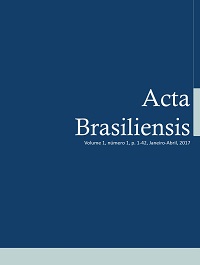Fibers of Cocos nucifera L. as sorbent of petroleum in marine environment
Abstract
The main environmental impacts caused by oil activities are derived from exploration, transportation and refining activities. Following the Gulf of Mexico accident in 2010, increased global environmental concern in developing methods and materials that have the ability to remove, recover and degrade oil. The present study aimed to take advantage of the coconut residue (Cocos nucifera L.) as sorbent in oil spill in the marine environment. The results showed that, in addition to the good sorption capacity of oil with a high presence of n-alkanes, the use of coconut fiber without heat treatment is better, whereas coconut fiber with heat treatment is more suitable for oil with high presence of resins and asphaltenes.
Downloads
References
American Society for Testing and Materials, 2005. Standard Test Method for Pour Point of Petroleum Products. ASTM D97. Acesso em 06 abr. 2010.
American Society for Testing and Materials, 1999a. Standard Test Method for Density and Relative Density of Crude Oils by Digital Density Analyzer. ASTM D5002.
American Society for Testing and Materials, 1999b. Standard Method of Testing Sorbent Performance of Adsorbents. ASTM F726-99.
Brandão, P. C. 2006. Avaliação do uso do bagaço de cana como adsorvente para a remoção de contaminantes, derivados do petróleo, de efluentes. Dissertação de Mestrado, Faculdade de Engenharia Química, Universidade Federal de Uberlândia, Uberlândia. 147p.
Brígida, A. I. S. 2010. Imobilização de lipases utilizando fibra da casca de coco verde como suporte para aplicações industriais. Tese de Doutorado, Escola de Química, Universidade Federal do Rio de Janeiro, Rio de Janeiro. 193p.
Britto, T. de A. F. 2008. Avaliação do tempo de residência de derrames de óleo no mar através do monitoramento de parâmetros geoquímicos – experimentos laboratoriais. Dissertação de Mestrado, Universidade Estadual Norte Fluminense, Rio de Janeiro. 222p.
Cerqueira, P. R DE. O. 2010. Proteção e limpeza de ambientes costeiros da ilha de Biopeba contaminados por petróleo: O uso alternativo da fibra de coco como barreiras e sorventes naturais. Dissertação de Mestrado, Universidade Católica do Salvador, Salvador, Bahia. 177p.
Chapman, H.; Purnell, K.; Law, R. J.; and Kirby, M. F. 2007. The use of chemical dispersants to combat oil spills at sea: A review of practice and research needs in Europe. Marine Pollution Bulletin, 54(7): 827-838.
Cooper, D., Gausemel, I. 2012. Oil spill sorbents: Testing protocol and certification listind program. 4p. Canada. Article 1993, Issue 1 (March 1993).
Cui, Y.; Xu, G.; Liu, Y.2014. Oil sorption mechanism and capability of cattail fiber assembly. Journal of Industrial Textiles, 43(3): 330–337.
Hubbe, M. A.; Rojas, O. J.; Fingas, M.; Gupta, B. S. 2013. Cellulosic substrates for removal of pollutants from aqueous systems: A Review. 3. Spilled oil and emulsified organic liquids. Bio Resources, 8(2): 3038-3097.
Ibrahim, I.; Hassan, M. Ali.; Abd-Aziz, S.; Shirai, Y.; Andou, Y.; Othman, M. R.; Ali, A. A. M.; Zakaria, M. R. 2017.
Reduction of residual pollutants from biologically treated palm oil mill effluent final discharge by steam activated bioadsorbent from oil palm biomass. Short communication. Journal of Cleaner Production, 141(10): 122-127.
Ibrahim, S.; Wang, S.; Ang, H.M. 2010. Removal of emulsified oil from oily wastewater using agricultural waste barley straw. Biochemical Engineering Journal, 49(1):78–83.
International Organization for Standardization, 1996. Crude petroleum and petroleum products - Determination of density - Oscillating U-tube method. ISO 12.185 Acesso em 05 nov. 2010
Khan, E.; Khaodhir, S.; Rotwiron, P. 2007. Polycyclic aromatic hydrocarbon removal from water by natural fiber sorption. Water Environment Research, 79(8): 901–911.
Li, Y.; Hu, C.; Yu, Y. 2008. Interfacial studies of sisal fiber reinforced high density polyethylene (HDPE) composites. Composites Part A: Applied Science and Manufacturing, 39(4): 570-578.
Mohammed, R.R.; Chong, M.F., 2014. Treatment and decolorization of biologically treated palm oil mill effluent (POME) using banana peel as novel biosorbent. Journal of Environmental Management, 132:237-249.
Moriwaki, H.; Kitajima, S.; Kurashima, M. 2009. Utilization of silkworm cocoon waste as a sorbent for the removal of oil from water. Journal of Hazardous Materials, 165 (1-3): 266–270. DOI: http://dx.doi.org/10.1016/j.jhazmat.2008.09.116
Parab, H.; Joshi, S.; Sudersanan, M.; Shenoy, N.; Lali, A.; Sarma, U. 2010. Removal and recovery of cobalt from aqueous solutions by adsorption using low cost lignocellulosic biomass-coir pith. Journal of Environmental Science and Health, Part A, Toxic/Hazardous Substances and Environmental Engineering, 45(5): 603-611.
Passos, P. R. A. 2005. Destinação sustentável de cascas de coco (Cocus nucifera) verde. Obtenção de telhas e chapas de partículas. Tese de Doutorado, Universidade Federal do Rio de Janeiro. Rio de Janeiro, 166p.
Queiroz, A. F. S.; Celino, J. J. 2008. Impacto ambiental da indústria petrolífera em manguezais da região norte da Baía de Todos os Santos (Bahia, Brasil). Editora UFPR. Boletim Paranaense de Geociências, 62-63: 23-34.
Radetic, M.; Vesna, I.; Radojevic, D.; Miladinovic, R.; Jocic, D.; Jovancic, P. 2008. Efficiency of recycled wool-based nonwovem material for the removal of oils from water. Chemosphere, 70(3): 525-530.
Ramos, R. R. 2014. Desenvolvimento de uma Metodologia de Cromatografia Líquida de Alta Eficiência (HPLC) para Análise de SARA de Petróleo. Dissertação de Mestrado, Universidade de São Paulo. São Paulo. 87p.
Selvam, P.V.P., Santiago, B.H. 2007. Tratamento superficial da fibra do coco: estudo de caso baseado numa alternativa econômica para fabricação de materiais compósitos. Revista Analytica, 26:783-788.
Sun, X. L. 2011. Study on the surface adsorption characteristics of natural cellulose fiber to oil. Master thesis, Donghua University, Shanghai, China.
U.S Environmental Protection Agency. 1996. Nonhalogenated Organics Using CG/FID. Test Method for evaluation solid waste physical/chemical methods. EPA 8015B.
Wong, K-F. V.; Barin, E.; Lane, J. 2002. Field experiments at the ohmsett facility for a newly designed boom system. Spill Science & Tecnology Bulletin, 7(5-6): 223-228.
Yusof, N. A.; Mukhair, H.; Malek, E. A.; Mohammad, F. 2015. Oil & esterified coconut coir. Bio Resources, 10(4): 8025-8038.






